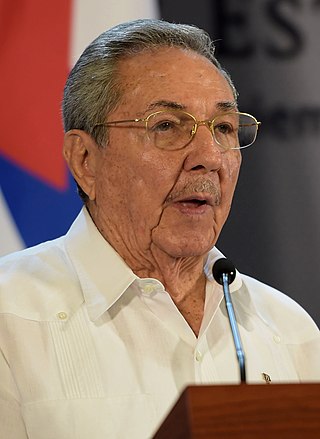
Raúl Modesto Castro Ruz is a Cuban retired politician and general who served as the first secretary of the Communist Party of Cuba, the most senior position in the one-party communist state, from 2011 to 2021, and President of Cuba between 2008 and 2018, succeeding his brother Fidel Castro.

The Cuban Revolution was the military and political overthrow of Fulgencio Batista's dictatorship, which had reigned as the government of Cuba between 1952 and 1959. The revolution began after the 1952 Cuban coup d'état, which saw Batista topple the nascent Cuban democracy and consolidate power. Among those opposing the coup was Fidel Castro, then a novice attorney who attempted to contest the coup through Cuba's judiciary. Once these efforts proved fruitless, Fidel Castro and his brother Raúl led an armed attack on the Cuban military's Moncada Barracks on 26 July 1953.
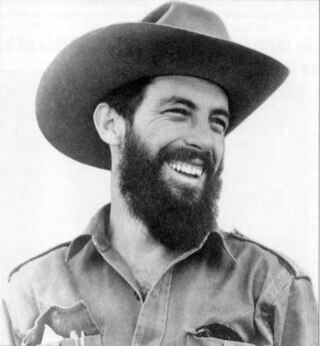
Camilo Cienfuegos Gorriarán was a Cuban revolutionary. One of the major figures of the Cuban Revolution, he was considered second only to Fidel Castro among the revolutionary leadership.
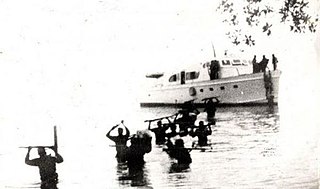
Granma is a yacht that was used to transport 82 fighters of the Cuban Revolution from Mexico to Cuba in November 1956 to overthrow the regime of Fulgencio Batista. The 60-foot diesel-powered vessel was built in 1943 by Wheeler Shipbuilding of Brooklyn, New York, as a light armored target practice boat, US Navy C-1994, and modified postwar to accommodate 12 people. "Granma", in English, is an affectionate term for a grandmother; the yacht is said to have been named for the previous owner's grandmother.

The 26th of July Movement was a Cuban vanguard revolutionary organization and later a political party led by Fidel Castro. The movement's name commemorates the failed 1953 attack on the Moncada Barracks in Santiago de Cuba, part of an attempt to overthrow the dictator Fulgencio Batista.
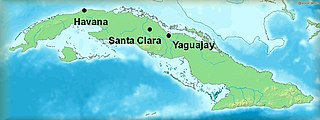
The Battle of Yaguajay was a decisive victory for the Cuban Revolutionaries over the soldiers of the Batista government near the city of Santa Clara in Cuba during the Cuban Revolution.

Operation Verano was the name given to the summer offensive in 1958 by the Batista government during the Cuban Revolution, known to the rebels as La Ofensiva. The offensive was designed to crush Fidel Castro's revolutionary army, which had been growing in strength in the area of the Sierra Maestra mountains since their arrival in Cuba on board the Granma yacht in December 1956. The offensive was met with resistance, notably at the Battle of La Plata and the Battle of Las Mercedes, and failed in its objective. The failure left the Cuban army dispirited and demoralized. Castro viewed it as a victory and soon launched his own offensive.

The Battle of La Plata(11-21 July 1958) was part of Operation Verano, the summer offensive of 1958 launched by the Batista government during the Cuban Revolution. The battle resulted from a complex plan created by Cuban General Cantillo to directly attack Castro's mountain base in the Sierra Maestra. The battle ended with the humiliating surrender of the assault battalion and the loss of some 500 Cuban army soldiers.

The Battle of Santa Clara was a series of events in late December 1958 that led to the capture of the Cuban city of Santa Clara by revolutionaries under the command of Che Guevara.
The Cuban Revolution was the overthrow of Fulgencio Batista's regime by the 26th of July Movement and the establishment of a new Cuban government led by Fidel Castro in 1959.
The military history of Cuba is an aspect of the history of Cuba that spans several hundred years and encompasses the armed actions of Spanish Cuba while it was part of the Spanish Empire and the succeeding Cuban republics.

The Triumph of the Revolution is the historical term for the flight of Fulgencio Batista on January 1, 1959, and the capture of Havana by the 26th of July Movement on January 8.

Melba Hernández Rodríguez del Rey was a Cuban politician and diplomat. She served as the Cuban Ambassador to Vietnam and to Cambodia.

Eulogio Amado Cantillo Porras was a major general in the Cuban Army. General Cantillo served as Chief of the Joint Staff during the dictatorship of Fulgencio Batista, but did not participate in the military coup that brought Batista to power. During the Cuban Revolution, he led Cuban soldiers in the fight against Fidel Castro's 26th of July Movement. After President Batista fled the country at 3:00 A.M. on January 1, 1959, he was left to serve briefly as the de facto Head of State in the early hours of January 1, 1959 until the official proclamation of the President of the Senate of Cuba, Anselmo Alliegro y Milá, as the Interim President of Cuba later that day. On January 2, 1959, the eldest judge of the Supreme Court, Carlos Manuel Piedra, was appointed as the Interim President by a junta led by him in accordance with the 1940 Cuban Constitution. However, the appointment of Piedra, the last president to be born under Spanish Cuba, was met with opposition from Castro, who believed that Manuel Urrutia should be appointed. After the Cuban Revolution, he was tried by the Revolutionary tribunals and sentenced to 15 years in prison. He was released early in the mid-1960s, and went into exile in Miami where he died on September 9, 1978.
The Cuban communist revolutionary and politician Fidel Castro took part in the Cuban Revolution from 1953 to 1959. Following on from his early life, Castro decided to fight for the overthrow of Fulgencio Batista's military junta by founding a paramilitary organization, "The Movement". In July 1953, they launched a failed attack on the Moncada Barracks, during which many militants were killed and Castro was arrested. Placed on trial, he defended his actions and provided his famous "History Will Absolve Me" speech, before being sentenced to 15 years' imprisonment in the Model Prison on the Isla de Pinos. Renaming his group the "26th of July Movement" (MR-26-7), Castro was pardoned by Batista's government in May 1955, claiming they no longer considered him a political threat while offering to give him a place in the government, but he refused. Restructuring the MR-26-7, he fled to Mexico with his brother Raúl Castro, where he met with Argentine Marxist-Leninist Che Guevara, and together they put a small revolutionary force intent on overthrowing Batista.
Alberto Roberto del Rio Chaviano was a Cuban brigadier general who served on the side of, and during Fulgencio Batista's dictatorship of Cuba (1952–1959). He studied high school at the Instituto de Santa Clara. In November 1933, he entered the Cuban National Army as a soldier. In 1951, he was retired with the rank of captain from the Army by the government of Carlos Prío. After Batista’s coup on March 10, 1952, he was promoted from captain to colonel. He was the chief colonel of the Moncada Barracks when Fidel Castro and his group attacked the barracks on July 26, 1953. He had an essential role to play in the military during Operation Verano. He played an important role in the defense of the Batista regime during the Cuban Revolution. During the dictatorship of Batista, he was put in charge of the Cuban Army in the region of Oriente in which Raúl Castro's guerrilla unit operated, and later in the Las Villas province Batista ordered his arrest for treason and he fled to the Dominican Republic on December 27, 1958. In that country he had a cattle ranch that was expropriated by the Dominican dictator Trujillo, and emigrated to the United States where he was a Spanish teacher. In 1963, he lived in Texas. He died of marrow cancer in the United States in 1978.
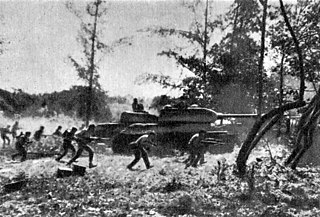
Tanks have been utilized on the island of Cuba both within the military and within several conflicts, with their usage and origin after World War II; the Cold War; and the modern era. This includes imported Soviet tanks in the Cuban Revolutionary Armed Forces today as well as American and British designs imported prior to the Cuban Revolution.

The Battle of Guisa was a relevant event in the history of Cuba. One of the major victories of the Rebel Army in the Liberation War (1956–1959) sustained against the dictatorship of Fulgencio Batista in Cuba.
José Quevedo Pérez was a Cuban soldier, commanding officer, and rebel, who served in the Cuban Constitutional Army, 26th of July Movement, and Cuban Revolutionary Army.

The Battle of Alegría de Pío was a battle in Cuba fought between the 26th of July Movement and the Cuban National Army. It was the first battle fought between the Cuban rebels and the Cuban military during the Cuban Revolution following the landing of 82 members of the movement, headed by Fidel Castro, on the southern coast of Cuba 3 days prior. In the aftermath of the battle, the rebels would be severely crippled, having suffered heavy casualties, and it would take many months for them to fully recover from the defeat.














